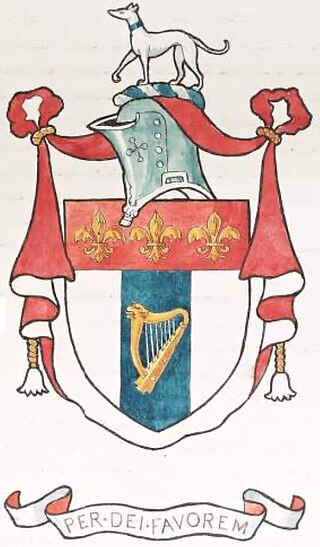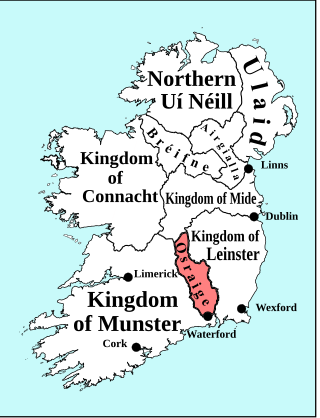Fitzpatrick is an Irish surname that most commonly arose as an anglicised version of the Irish patronymic surname Mac Giolla Phádraig "Son of the Devotee of (St.) Patrick".

Brophy is an Irish surname of ancient origin, which is derived from the Irish "Uí Bhróithe" or "Ó Bróithe" septs that were located mostly around Ballybrophy, Laois, and in counties Carlow and Kilkenny. The family has been prominent in the history of Ireland for nearly 1000 years and has included petty kings (Rí), clerics, soldiers, and writers. The family was first mentioned in the late 11th century, but as a member of the Dál Birn dynasty, its semi-legendary genealogy stretches back to AD 200 according to the Bodleian Library, MS Rawlinson B 502. As such, it remains one of Ireland's oldest extant pre-Norman Conquest noble families, being related to the kings of Osraige and the Fitzpatrick dynasty as represented by the Earl of Upper Ossory, Baron Upper Ossory, and Baron Castletown.

Osraige or Osraighe, Osraí, anglicized as Ossory, was a medieval Irish kingdom comprising what is now County Kilkenny and western County Laois, corresponding to the Diocese of Ossory. The home of the Osraige people, it existed from around the first century until the Norman invasion of Ireland in the 12th century. It was ruled by the Dál Birn dynasty, whose medieval descendants assumed the surname Mac Giolla Phádraig.
Donoghue or O'Donoghue is an anglicised form of the Irish language surname Ó Donnchadha or Ó Donnchú.
Cerball mac Dúnlainge was king of Ossory in south-east Ireland. The kingdom of Ossory (Osraige) occupied roughly the area of modern County Kilkenny and western County Laois and lay between the larger provincial kingdoms of Munster and Leinster.
The Fragmentary Annals of Ireland or Three Fragments are a Middle Irish combination of chronicles from various Irish annals and narrative history. They were compiled in the kingdom of Osraige, probably in the lifetime of Donnchad mac Gilla Pátraic, king of Osraige and of king of Leinster. A major narrative within the text is the so-called "Osraige Chronicle" which greatly focuses on the exploits of the ninth century king of Osraige, Cerball mac Dúnlainge, who was the paternal ancestor of the medieval Mac Giolla Phádraig family.

Ivar of Waterford was the Norse king of Waterford from at least 969 until his death in the year 1000, and also reigned as King of Dublin, possibly from 989 to 993, and certainly again for less than a year between 994 and 995, returning after his expulsion from the city in 993 by Sigtrygg Silkbeard, who would expel him for good the next time.
Barnaby Fitzpatrick (c.1478–1575) was the last person to have claim to the kingship of Osraige; forfeiting his ancestral title in favour of being created the first Lord Baron Upper Ossory by King Henry VIII of England, by patent dated 11 June 1541, as part of the King's policy of Surrender and regrant. Barnaby Fitzpatrick was subsequently knighted on 1 July 1543.

Mac Giolla Phádraig is a native Irish dynastic surname which translates into English as "Son of the Devotee of (St.) Patrick". In the medieval period, the Mac Giolla Phádraigs were hereditary kings of Osraige; today, the anglicised version of the name is commonly "Fitzpatrick".
Óengus Osrithe son of Criomthann Mór and his wife Cindnit, daughter of Dáire mac Degad and Morand, was the semi-legendary first king and eponymous ancestor of the Osraige people of Ireland. His supposed floruit lies in the late first or early second century AD.
Dál Birn is a tribal epithet found in Irish sources which refers to the descendants of Loegaire Birn Buadach, the hereditary ruling lineage of the kingdom of Osraige in Ireland.
Florence Fitzpatrick, 3rd Baron Upper Ossory, was the third son of Barnaby Fitzpatrick, 1st Baron Upper Ossory and his wife Margaret Butler, and inherited the title upon the death of his older brother Barnaby Fitzpatrick, 2nd Baron Upper Ossory in 1581. He married Catherine O'More, daughter of Patrick O'More of Abbeyleix, and had six children, including his son Teige, who succeeded as 4th Baron, and Joan who married John Butler of Dunboyne, by whom she was the mother of Edmond Butler, 3rd/13th Baron Dunboyne.
Barnaby Fitzpatrick, 5th Baron Upper Ossory was the son and heir of Teige Fitzpatrick, 4th Baron Upper Ossory.
Riagan mac Dúnlainge was king of Osraige from 888 to 894 AD.
Cellach mac Cerbaill was king of Osraige from 905 to his death in 908.
Ailill mac Fáeláin was a King of Osraige in the south east of Gaelic Ireland. Ailill was of a dynasty known as the Dál Birn. Osraige was located in modern County Kilkenny, Ireland.

Grangefertagh is a former abbey located in County Kilkenny, Ireland. It is today a National Monument.
Donnchad mac Gilla Pátraic, was King of Osraige and King of Leinster.
Gilla Pátraic mac Donnchada was king of Osraige and the progenitor from whom all Mac Giolla Phádraigs (Fitzpatricks) of Ossory took their hereditary surname. Gilla Pátraic succeeded his father Donnchad mac Cellaig in 976. Donnchad mac Cellaig was the son of Cellach mac Cerbaill, king of Osraige and his wife, Echrad ingen Matudán. After a reign of 21 years, Gilla Pátraic was slain by Donnabhan, king of the Danes of Waterford, and Domhnall, king of the Desies. By his wife, Maelmuire, he had five sons: (1) Donnchad mac Gilla Pátraic, king of Osraige and king of Leinster; (2) Dunghal ; (3) Tadhg ; (4) Diarmaid ; and, (5) Muircheartach.
Donnchad mac Cellaig reigned as king of Osraige from AD 934 to 976. He was the son of Cellach mac Cerbaill, king of Osraige and his wife, Echrad ingen Matudán. He succeeded to the throne on the death of his brother Cuilen, and ruled his native territory with great distinction and credit to himself for more than 40 years.





